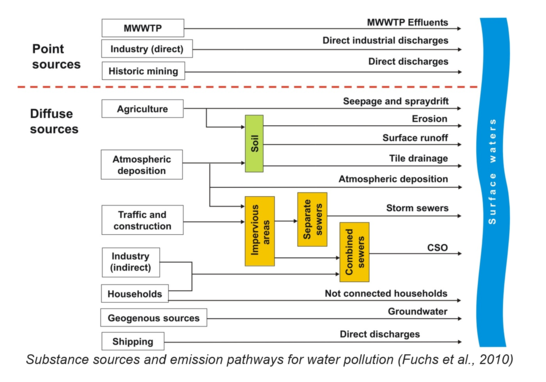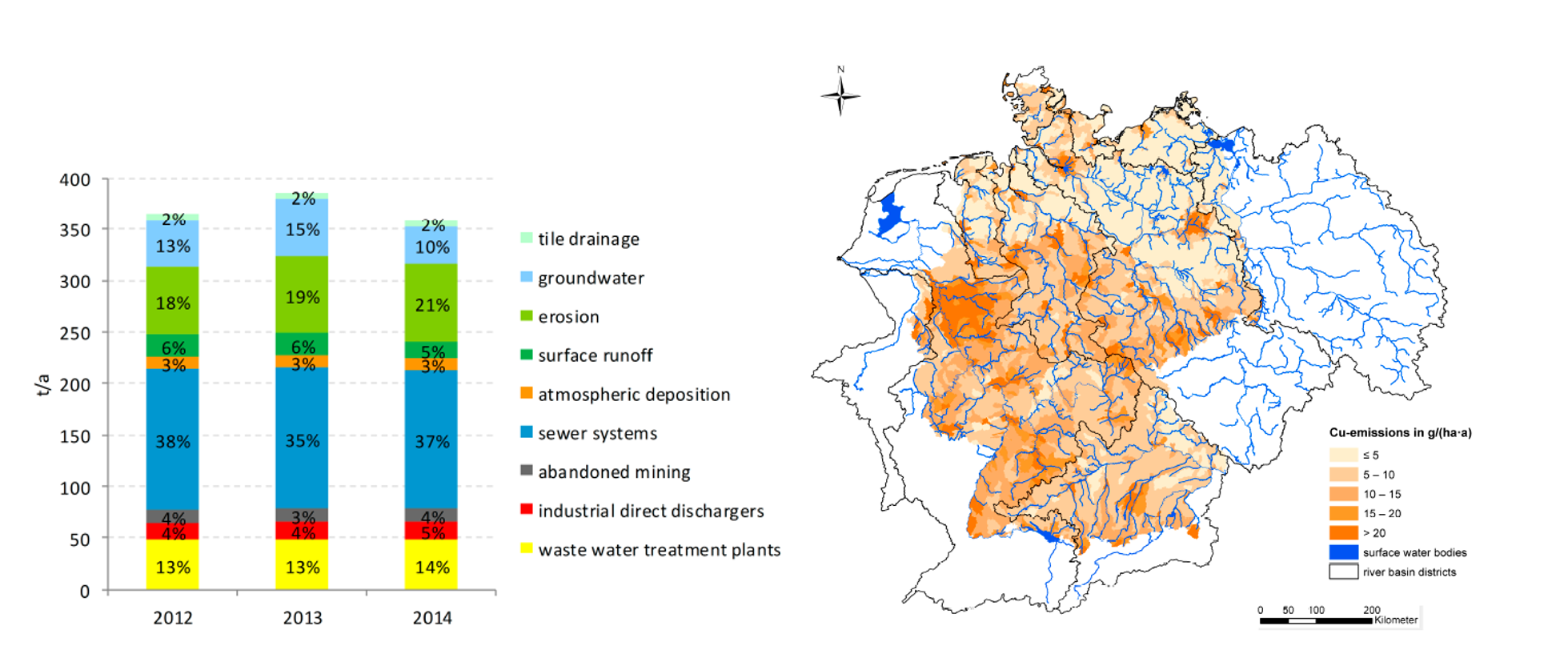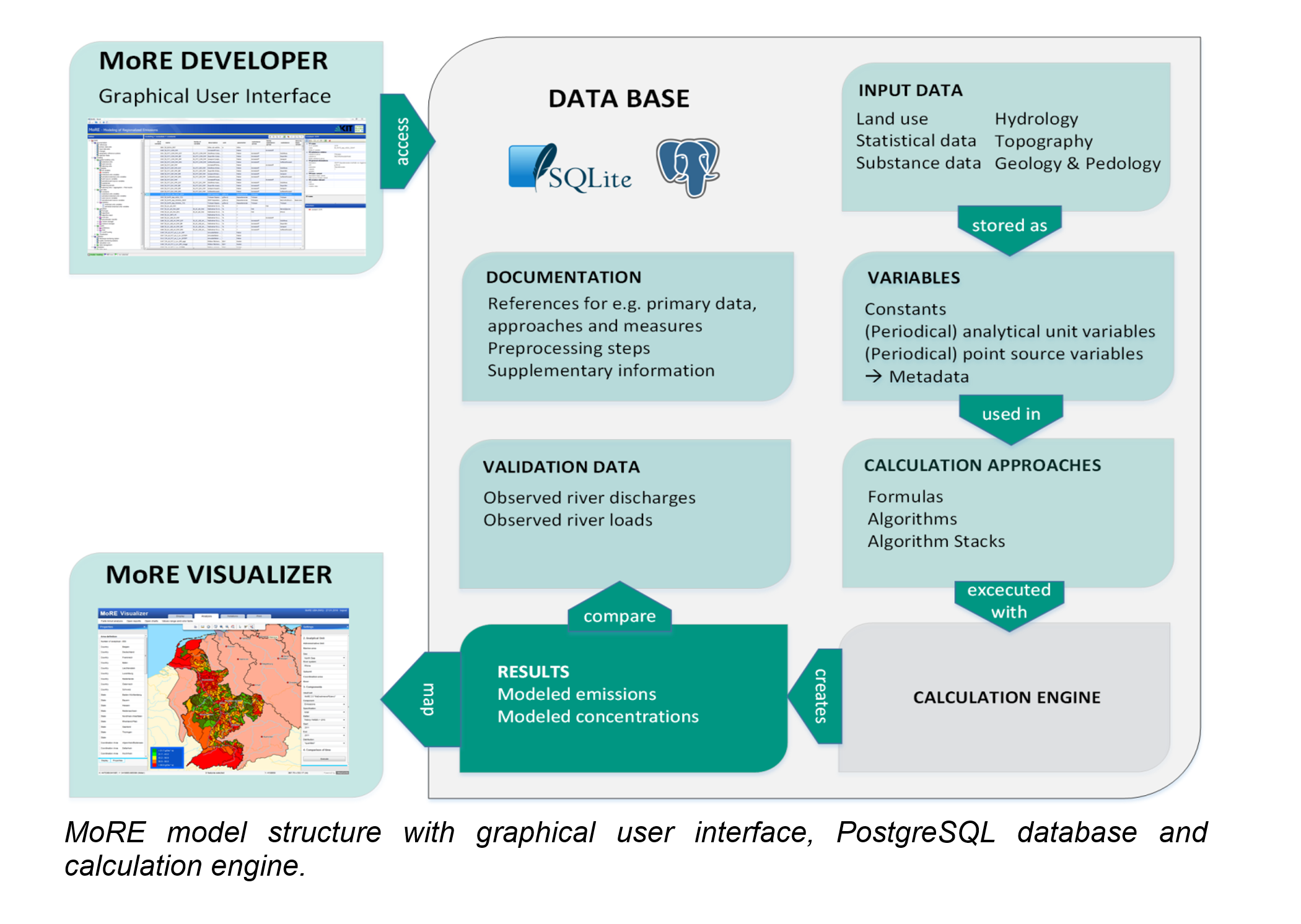MoRE (Modeling of Regionalized Emissions)
The model system MoRE (Modeling of Regionalized Emissions) was developed in cooperation with the German Federal Environment Agency. It is based on the MONERIS model system. MoRE was developed as a tool in an open source environment for modelling substance emissions into surface waters for a wide range of substances with relevance for water quality. Modelled emissions are handed over to the Federal Environment Agency (https://www.umweltbundesamt.de/daten/wasser/fliessgewaesser/eintraege-von-naehr-schadstoffen-in-die ).
At present, emissions for the following substances can be modelled in MoRE for Germany:
- Nutrients (nitrogen, phosphorus)
- Heavy metals (Cd, Cr, Cu, Hg, Ni, Pb, Zn)
- Polycyclic aromatic hydrocarbons (PAH16, benzo(a)pyrene)
- Pharmaceuticals (diclofenac, ibuprofen, iomeprol, sulfamethoxazole)
- pesticides (diuron, isoproturon)
- Phenols (nonylphenol, octylphenol)
- Phthalates (DEHP)
- Terbutryn
- Triclosan
The modelling in MoRE is carried out as a regionalized path analysis. The substance emissions are modelled with temporal and spatial differentiation via various emission pathways. Thereby, a distinction is made between point and diffuse sources. The following emissions pathways are implemented in MoRE:
Point sources:
- Municipal wastewater treatment plants
- industrial direct dischargers
- emissions from abandoned mining (for heavy metals)
Diffuse source pathways:
- Sewer systems
- Surface runoff
- Erosion
- Groundwater
- Tile drainage
- direct atmospheric deposition onto water surface
- inland navigation (for polycyclic aromatic hydrocarbons)
Due to the flexible structure of MoRE, new substances and emission pathways can be integrated at any time, provided that the necessary input data are available and modelling can be carried out in a reasonable way. In addition, MoRE offers the possibility to modify existing calculation approaches and to compare these. For this purpose, different variants can be created.
In the MoRE database, nation-wide discharge and water quality data of measuring stations are stored, from which observed river loads are calculated. These can be compared with the modelled loads to validate the calculated emissions.
In addition to the modelling of emissions, MoRE also enables the calculation and evaluation of water protection measures at river basin level, e.g. adjustments in the operation of municipal wastewater treatment plants or a connection increase of the population to existing sewer systems.
Links: Modelled copper emission into surface waters in Germany via different emission pathways for the years 2012-2014. Right: Mean area-specific copper emissions into surface waters modelled for the years 2012-2014. (from Fuchs et al. 2017 - https://doi.org/10.3390/w9040239)
Model structure
The MoRE model system is based on an open source PostgreSQL/SQLite database, a generic calculation engine and the MoRE Developer user interface, which can be used to read, modify and extend the contents of the database. All computations are performed by the calculation engine, which is controlled via the user interface. The modelling results can be exported as tables via the MoRE Developer user interface and the results can be used in GIS for mapping. Users can work with MoRE in two different ways: on the basis of a multi-user access in a PostgreSQL database via the Internet or as a stand-alone application on the PC (SQLite version). More information on how to use MoRE can be found in the manual and in our MoRE-Wiki.
Applications of MoRE
The flexible structure of MoRE allows the adaptation of the modelled substances and emission pathways. Furthermore, the spatial modeling units can be replaced, which allows the consideration of other river basins. While the development of the original MoRE database is continued for all German river basin districts, the model was and is used at the IWG for detailed analyses in sub-basins and different projects:
- Inn catchment: On behalf of the Federal Environment Agency, the transboundary harmonization of input data and calculation approaches was investigated in the Inn catchment in cooperation with the Austrian Federal Environment Agency and the Bavarian State Office for the Environment. Link: Inn-Project
- Baden-Württemberg: Im Auftrag der Landesanstalt für Umwelt, Messungen und Naturschutz (LUBW) Baden-Württemberg: On behalf of the authority for the Environment, Measurements and Conservation in Baden-Württemberg (LUBW), a detailed analysis of nutrient emissions with best available data was carried out for the water bodies of Baden-Württemberg. Link: METRIS-Project
- Nidda: In the joint project NiddaMan, funded by the BMBF, MoRE was adapted for the catchment of the Nidda River in Hesse with the question of necessary temporal and spatial resolution for water quality modelling. Link: NiddaMan
- Nordrhein-Westfalen: In cooperation with the State Authority for Nature, Environment and Consumer Protection of North Rhine-Westphalia (LANUV), modelling of nutrient and mercury emissions into surface waters of North Rhine-Westphalia was carried out with special regard to rainwater discharges. Link: NRW-Project
- Luxembourg: due to the reporting demand of the Water Framework Directive, the data basis for the modelling of nutrient discharges in Luxembourg was compiled and will be further elaborated in a follow-up project. Link: Lux-Project
- Brazil: In cooperation with partners from research and practice, MoRE is used for the modelling of nutrient emissions in the catchment area of the Passauna dam. Link: Mudak-page
Further information
On the web pages of the Federal Environment Agency
Model coupling: Water balance and substance emissions (in German): https://www.umweltbundesamt.de/themen/modelle-kombinieren-wasserhaushalt
Substance emissions into water bodies (in German): https://www.umweltbundesamt.de/themen/wasser/fluesse/nutzung-belastungen/stoffeintraege-in-gewaesser
Emissions of nutrients and pollutants into surface waters (in German): https://www.umweltbundesamt.de/daten/wasser/fliessgewaesser/eintraege-von-naehr-schadstoffen-in-die#nahrstoffeintrage-sinken-wieder-langsam
Pollutants from sewer systems into water bodies (in German): https://www.umweltbundesamt.de/themen/wasser/fluesse/nutzung-belastungen/schadstoffe-aus-kanalisationen-in-gewaessern#schadstoffe-im-urbanen-abwassersystem
Protecting water bodies requires efficient wastewater treatment (in German): https://www.umweltbundesamt.de/themen/wasser/fluesse/nutzung-belastungen/gewaesserschutz-benoetigt-effiziente#stoffe-in-klaranlagen
For further information on MoRE, please refer to the following publications:
Morling, K.; Fuchs, S.; Krumm, J.; Haag, I. (2024): Zusammenführung der bundesweiten Modellierung von Wasserhaushalt (LARSIM-ME) und Stoffeinträgen (MoRE). UBA Texte | 37/2024. Umweltbundesamt. Online verfügbar unter: https://www.umweltbundesamt.de/publikationen/zusammenfuehrung-der-bundesweiten-modellierung-von
Fuchs, S.; Brecht, K.; Gebel, M.; Bürger, S.; Uhlig, M.; Halbfaß, S. (2022): Phosphoreinträge in die Gewässer bundesweit modellieren – Neue Ansätze und aktualisierte Ergebnisse von MoRE-DE. UBA Texte | 142/2022. Umweltbundesamt. Online verfügbar unter: https://www.umweltbundesamt.de/publikationen/phosphoreintraege-in-die-gewaesser-bundesweit
Fuchs, Stephan; Rothvoß, Shari; Toshovski, Snezhina (2018): Ubiquitäre Schadstoffe – Eintragsinventare, Umweltverhalten und Eintragsmodellierung. Abschlussbericht (Forschungskennzahl 3714 21 200 0). Umweltbundesamt (UBA) (TEXTE, 52/2018). Online verfügbar unter https://www.umweltbundesamt.de/publikationen/ubiquitaere-schadstoffe-eintragsinventare.
Fuchs, S.; Kaiser, M.; Kiemle, L.; Kittlaus, S.; Rothvoß, S.; Toshovski, S.; Wagner, A.; Wander, R.; Weber, T.; Ziegler, S. (2017): Modeling of Regionalized Emissions (MoRE) into Water Bodies: An Open-Source River Basin Management System. Water 2017, 9, 239, doi:10.3390/w9040239. [LINK: https://www.mdpi.com/2073-4441/9/4/239]
Fuchs, Stephan; Weber, Tatyana; Wander, Ramona; Toshovski, Snezhina; Kittlaus, Steffen; Reid, Lucas et al. (2017): Effizienz von Maßnahmen zur Reduktion von Stoffeinträgen. Endbericht. 1. Aufl. 1 Band. Dessau-Roßlau: Umweltbundesamt (TEXTE, 05/2017). Online verfügbar unter https://www.umweltbundesamt.de/sites/default/files/medien/1968/publikationen/2017-01-17_texte_05-2017_masnahme_neffizienz-stoffeintrage_komp.pdf .
Fuchs, Stephan; Scherer, Ulrike; Wander, Ramona; Behrendt, Horst; Venohr, Markus; Opitz, Dieter et al. (2010): Berechnung von Stoffeinträgen in die Fließgewässer Deutschlands mit dem Modell MONERIS. Nährstoffe, Schwermetalle und Polyzyklische aromatische Kohlenwasserstoffe. 1. Aufl. 1 Band. Dessau-Roßlau: Umweltbundesamt (TEXTE, 45/2010). Online verfügbar unter http://www.umweltbundesamt.de/sites/default/files/medien/461/publikationen/4017.pdf .
MoRE Developer
If you are interested in using MoRE for modelling substance emissions in river basins, please contact us:
- PD Dr.-Ing Stephan Fuchs stephan fuchs ∂does-not-exist.kit edu
The nationwide database of MoRE, maintained on behalf of the Federal Environment Agency, contains numerous data which have been made available either by the Federal Environment Agency itself, the federal states or other third parties under user agreements for the modelling of substance emissions with MoRE. Therefore, it is only possible for us to provide an empty MoRE SQLite version without data content for interested parties. As an interested user, you can fill it with your own content for testing purposes. Information on how to use MoRE can be found in our manual and on the MoRE-Wiki.



